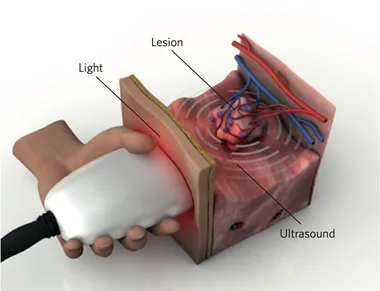MSOT: Multispectral Optoacoustic Tomography

Figure: CBI
Multispectral Optoacoustic Tomography (MSOT) is a modern biomedical imaging technique that enables scientists and clinicians to monitor biological processes in real time. As the name suggests, this non-invasive method, which does not require contrast agents, consists of three components:
Optoacoustic refers to the signal generation process, in which tissue is stimulated by laser energy, causing it to briefly expand due to light absorption. As it contracts, it emits an acoustic signal that is then captured by suitable detectors. This allows MSOT to combine deep tissue penetration with high imaging contrast. Since different biological components have distinct absorption spectra, multispectral refers to the simultaneous imaging of multiple absorbers and the ability to distinguish between them. Based on their unique spectral signatures, the sensitivity of the method can be enhanced. Tomography refers to the use of mathematical methods to reconstruct a complete 3D image from the collected acoustic signals.
Thanks to its attractive properties, MSOT quickly gained positive recognition and evolved from a laboratory prototype into a reliable device within a very short time. The MSOT technology and its variants are currently used in both basic research and clinical imaging—for example, in dermatology as a handheld scanner, as shown in the figure below. Additionally, MSOT is used in oncology for early detection, metastasis assessment, and therapy monitoring. Further applications currently under development include diabetes, inflammation, and drug research, to name just a few.